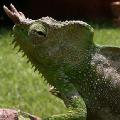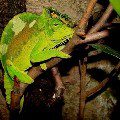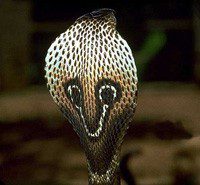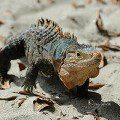
Chameleon four-horned
In a figurative sense, the nickname “chameleon” refers to a fickle and changeable person, which confirms a vivid example from the classics – Chekhov’s story “Chameleon”. However, in the literal sense, a chameleon is, of course, a lizard, however, it is also quite variable. Its inconstancy is expressed in a periodically changing color. But this is far from the only unusual quality of the reptile, as well as its ability to adopt the features of the surrounding world. The specific names of chameleons themselves reflect their features similar to other representatives of wildlife. For example, the leopard chameleon is distinguished by its reddish spotted-striped color, which makes it related to the feline predators of the same name. But in this article we will focus on the four-horned chameleon, which earned its name because of the hard, elongated processes on its head.
Contents
Classification
Kingdom: Animals
Type: Chord
Class: Reptiles
Order: Scaly
Suborder: Lizards
Family: Chameleons
Genus: Real chameleons
Species: Four-horned chameleon, Chamaeleo Trioceros quadricornis
Appearance
 The four-horned chameleon is medium in size among all members of the family. Males of this species rarely exceed 25-35 cm, and females are even smaller, but more well-fed. In captivity, the lizard lives somewhat longer than its other relatives – up to 5 years. The reptile does not always have all 4 horns, sometimes there are 3 of them, and the fourth one is not sufficiently developed. On the back and belly of the chameleon there are horny ridges that stretch to the very tail. The lower one comes from the jaw itself, and the upper one resembles a fish fin and is nothing more than overgrown bony processes of the spine. Female four-horned chameleons, despite the name, may not have horns at all or have something like their beginnings. The dorsal crest in females is slightly thickened. The basic color tone of four-horned reptiles varies from blue to dark green and black with wavy blue-white patterns, and red color prevails in the jaw area. The body of the lizards is flattened on the sides, the paws resemble grasping claws, the fingers, arranged in groups and enclosed in a common leather bag, have sharp claws. Tenacious paws allow the four-horned chameleon to deftly move along the branches of trees. The lizard’s tail is also adapted for such movement, capable of twisting into a spiral and wrapping itself around branches and trunks. If necessary, the lizard easily hangs, catching it on a branch.
The four-horned chameleon is medium in size among all members of the family. Males of this species rarely exceed 25-35 cm, and females are even smaller, but more well-fed. In captivity, the lizard lives somewhat longer than its other relatives – up to 5 years. The reptile does not always have all 4 horns, sometimes there are 3 of them, and the fourth one is not sufficiently developed. On the back and belly of the chameleon there are horny ridges that stretch to the very tail. The lower one comes from the jaw itself, and the upper one resembles a fish fin and is nothing more than overgrown bony processes of the spine. Female four-horned chameleons, despite the name, may not have horns at all or have something like their beginnings. The dorsal crest in females is slightly thickened. The basic color tone of four-horned reptiles varies from blue to dark green and black with wavy blue-white patterns, and red color prevails in the jaw area. The body of the lizards is flattened on the sides, the paws resemble grasping claws, the fingers, arranged in groups and enclosed in a common leather bag, have sharp claws. Tenacious paws allow the four-horned chameleon to deftly move along the branches of trees. The lizard’s tail is also adapted for such movement, capable of twisting into a spiral and wrapping itself around branches and trunks. If necessary, the lizard easily hangs, catching it on a branch.
Among chameleons there is a whole group of horned species. As for the four-horned lizard specifically, it has two pairs of such short horns located right at the end of the muzzle, one behind the other. In addition, the four-horned chameleon has the full range of unusual qualities that are characteristic of the family. He has large, bulging eyes that cannot be seen in their entirety, as they are covered with continuous leathery eyelids, leaving an opening only for the pupil. These eyes can rotate in different directions, so that the enemy is unlikely to be able to get close to the chameleon unnoticed. And this lizard knows how to disguise itself, changing not only the color, but also the shape of the body. In general, in the face of a four-horned chameleon, we see a truly unique creature that deserves a detailed discussion.
The external structure of the reptile’s head is somewhat reminiscent of a medieval knight’s shell, it has bizarre crests, mounds and, of course, horns. The scales of a four-horned chameleon are bumpy, in this epidermis there are grains of pigments responsible for changing the color of the body – from black to red and yellow. The mechanism of their action is as follows: if the processes of these grains are reduced, then all the pigment accumulates in their bodies and the lizard becomes yellowish-white. And when the pigment penetrates into the processes, then the color of the chameleon changes from light to dark. The upper layer of the skin of a four-horned chameleon contains additional crystals of the guanine pigment, due to which other shades – green and blue – are mixed with the color of the reptile. Moreover, pigmentation can change in different parts of the body in different ways, which, as a result, produces an amazing effect of colors and various patterns on the head and body of the lizard. Forcing a four-horned chameleon to change color is deliberately impossible. He is able to do this only in accordance with his internal state, expressing fear, attracting the opposite sex, showing aggression or disguising himself. And also in four-horned chameleons, yes, in general, and in other members of the family, the language is surprisingly arranged. It is incredibly long, thickened at the end and shaped like a cylinder with a cavity in the middle. With its help, the chameleon hunts, throwing out his tongue with lightning speed and hitting his prey with it. Due to the internal cavity, a suction cup is formed at the end of the tongue, to which the victim is glued. This suction cup is able to hold a load weighing up to 50 grams. The movements of the tongue of a four-horned chameleon are so fast that a person is not able to track them. This speed is reported to him by a strong contraction of the circular muscles and a sharp flow of blood.
Distribution and habitation
Four-horned chameleons not only look like creatures out of this world, but also live in places difficult for humans, for example, in the mountain forests of Cameroon and Nigeria. Sometimes they take root on the slopes of extinct volcanoes. And only occasionally can reptiles be found in the hilly African savannas. These lizards need a humid climate, warmth and access to drinking water. The climate of Cameroon fully provides them with such conditions. However, four-horned chameleons are quite resistant creatures, they can easily endure a temperature drop of up to 10 degrees.
Behavior and lifestyle
 Four-horned chameleons are loners. In relation to people and relatives, they often show aggression, however, not as strong as that of lizards of some other species. Therefore, keeping two males in one terrarium is strongly discouraged. Regarding the function of the horns in the scientific literature, there are quite contradictory information. For example, Darwin suggested that chameleons use them in fights. And according to other sources, horns allow lizards to distinguish each other within the same species. And the third least likely version says that with the help of horns, chameleons scare away the enemy.
Four-horned chameleons are loners. In relation to people and relatives, they often show aggression, however, not as strong as that of lizards of some other species. Therefore, keeping two males in one terrarium is strongly discouraged. Regarding the function of the horns in the scientific literature, there are quite contradictory information. For example, Darwin suggested that chameleons use them in fights. And according to other sources, horns allow lizards to distinguish each other within the same species. And the third least likely version says that with the help of horns, chameleons scare away the enemy.
During movement, reptiles can give the impression of slow and clumsy creatures. However, they are able to overcome considerable distances, according to the principle “quieter you go – you will continue.” Each step of the four-horned chameleon seems to be deliberate. First, one limb goes forward, then a couple of minutes of “thinking” comes, and only then the other leg comes forward. Sometimes chameleons can dance. This feature is vividly described by the researcher Darell. According to him, while moving, lizards can smoothly lift their hind and forelimbs into the air and swing rhythmically for some time, rotating their eyes like periscopes. Scientists have not yet found an explanation for this behavior, suggesting that this is a special sign language – communication between different individuals. Four-horned chameleons also hunt almost motionless, hiding in ambush and accurately shooting their tongues at insects crawling and flying past. During the daytime, reptiles love to bask in the sun and can spend hours in immobility, descending to the ground only to lay their eggs.
Lizards hunt, as already mentioned, with the help of a tongue, the movement of which is akin to a shot with a cherry stone clamped in the fingers. But, of course, the lizard’s tongue does not fly away at all, but only reaches the victim. A four-horned chameleon is able to catch an insect from a distance of up to 30 cm. And if they are too far away, then the lizard will very slowly approach its prey, freezing after each step. At the same time, one eye of the chameleon is focused on the victim, while the other rotates in different directions to replace the approach of danger from the outside. In addition to the suction cup, which we described in the “Appearance” section, there is another amazing device at the end of the reptile’s tongue – a long proboscis that wraps around the already caught prey for better retention. In general, information about the structure of the chameleon language varies in different sources. However, the version about the sticky gland at its end, mentioned in articles about other types of chameleons, scientists prefer to call outdated.
Food
 Four-horned chameleons should be fed with locusts, cockroaches, crickets, flies, after sprinkling this food with powdered vitamin supplements. A tall glass or even a cut-off plastic bottle can be used as a feeding “tool”. Several insects should be placed in this container and placed under a branch so that the chameleon can reach the food with its tongue. You can give food to lizards every other day. Drinking water is more difficult, because four-horned chameleons do not drink from ordinary drinkers. A small fountain or dropper can successfully replace this device. You can also spray the vegetation in the terrarium so that the chameleons lick the moisture from the leaves. Some owners prefer to give their pet water from a pipette or syringe. It is better for newborn lizards to give small insects. Adults can alternatively be fed with tweezers. It is advisable to add chopped fresh fruits and juicy greens to the diet. By the way, the original way to drink a chameleon was invented for especially aggressive individuals. When the lizard in a fit of rage begins to open its mouth wide, you can try to inject water into it. Water is successfully replaced by natural fruit juice and a weak honey solution. You can learn how to lure live “food” for lizards by placing pieces of missing fruit in an open-air enclosure. Insects themselves will flock to them, and your pet will have something to eat.
Four-horned chameleons should be fed with locusts, cockroaches, crickets, flies, after sprinkling this food with powdered vitamin supplements. A tall glass or even a cut-off plastic bottle can be used as a feeding “tool”. Several insects should be placed in this container and placed under a branch so that the chameleon can reach the food with its tongue. You can give food to lizards every other day. Drinking water is more difficult, because four-horned chameleons do not drink from ordinary drinkers. A small fountain or dropper can successfully replace this device. You can also spray the vegetation in the terrarium so that the chameleons lick the moisture from the leaves. Some owners prefer to give their pet water from a pipette or syringe. It is better for newborn lizards to give small insects. Adults can alternatively be fed with tweezers. It is advisable to add chopped fresh fruits and juicy greens to the diet. By the way, the original way to drink a chameleon was invented for especially aggressive individuals. When the lizard in a fit of rage begins to open its mouth wide, you can try to inject water into it. Water is successfully replaced by natural fruit juice and a weak honey solution. You can learn how to lure live “food” for lizards by placing pieces of missing fruit in an open-air enclosure. Insects themselves will flock to them, and your pet will have something to eat.
Reproduction
 The mating season for four-horned chameleons is perhaps the most nervous time. They become especially aggressive and irritable, often changing color, hissing and inflating the body, frightening all possible enemies. Males are able to arrange not only demonstrative, but also quite bloody battles, in which sometimes they use horns and also bite. Several females usually live on the site of a male four-horned chameleon – this harem is carefully protected from other people’s encroachments. Females are distinguished by the presence of special seminal receptacles, in which they retain the cells of the male for reproduction for a long time. For such a female, one mating is enough to make several clutches in the future with a short interval. The development time of embryos inside the body of a lizard is 1-5 months. The number of eggs in the clutch of a four-horned chameleon is 3-8 pieces. Incubation lasts six months. The young that are born become sexually mature in another six months.
The mating season for four-horned chameleons is perhaps the most nervous time. They become especially aggressive and irritable, often changing color, hissing and inflating the body, frightening all possible enemies. Males are able to arrange not only demonstrative, but also quite bloody battles, in which sometimes they use horns and also bite. Several females usually live on the site of a male four-horned chameleon – this harem is carefully protected from other people’s encroachments. Females are distinguished by the presence of special seminal receptacles, in which they retain the cells of the male for reproduction for a long time. For such a female, one mating is enough to make several clutches in the future with a short interval. The development time of embryos inside the body of a lizard is 1-5 months. The number of eggs in the clutch of a four-horned chameleon is 3-8 pieces. Incubation lasts six months. The young that are born become sexually mature in another six months.
Sources of
http://chamaeleon.ru/
http://bio.1september.ru/
http://ours-nature.ru/
http://grench21.narod.ru/





